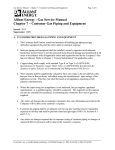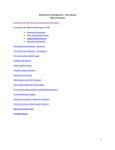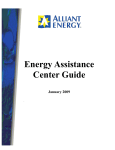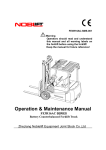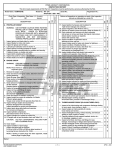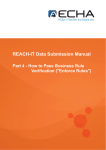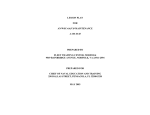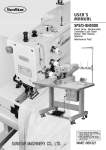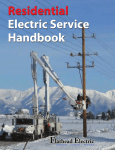Download CHAPTER 5 - Alliant Energy
Transcript
Chapter 5 ELECTRIC SERVICE RULES GENERATION Issued Oct. 2015 CHAPTER 5 ELECTRIC SERVICE RULES –DISTRIBUTION GENERATION 500. SCOPE This chapter applies to customer‐owned portable (temporary) or permanently mounted generation. The Chapter is divided in two parts: Part A which addresses optional standby systems; these are not operated in parallel with AE electric distribution system. Part B which addresses distributed generation (DG) systems; these do operate in parallel with Alliant Energy’s electric distribution system. Consult Alliant Energy for these and all other generation installations. _____________________________________________________________________________ DISTRIBUTION GENERATION ‐ OPTION STANDBY (Part A) 501. SAFETY A. The customer shall consult Alliant Energy before connecting any generating equipment to any customer circuit that is or can be supplied from Alliant Energy’s electric distribution system. B. Transfer switches may only be located before the main service disconnects where the available fault current is less than 10,000 amps. C. The customer’s transfer device shall be constructed and connected as to positively prevent any possibility of power from the customer’s emergency source feeding back into Alliant Energy’s distribution system 502. TRANSFER SYSTEM REQUIREMENTS a. The customer may supply all or a portion of his electrical load from his standby generator. b. The customer shall install a transfer switch or contactor to transfer all ungrounded conductors load to either the generator or normal supply. c. Alliant Energy shall approve automatic transfer systems. d. All transfer devices shall: a. Prevent connecting the generator to the load until after the load is disconnected from Alliant Energy’s system. Exception: Closed transition type transfer switches that interconnect the emergency generators and the normal supply for a maximum of 100 milliseconds (1/10 second). Page121 Chapter 5 ELECTRIC SERVICE RULES GENERATION Issued Oct. 2015 b. Positively prevent accidental connection of the generator to Alliant Energy’s system at any time. c. Closed transition type transfer switches shall have a lockable, visually open break in the circuit between the normal supply and the transfer switch. NOTES: Closed transition = Close before Break, no disruption to load. Open transition = Open before Break, requires disruption to load. 503. TRANSFER SWITCH OPTIONS. a. Permitted: 1. Manual or automatic double throw switches 2. Double throw relays 3. Mechanically interlocked switches 4. Mechanically interlocked fuse block b. Permitted in dry, corrosion free, dust free environments, such as indoors: 1. Breakers with factory designed mechanical interlocks c. Not permitted: 1. Key interlocked switches 2. Key interlocked breakers 3. Switches that plug into the meter‐socket unless listed in ESE section E231 (See 504(b) below). 4. The addition of splices or taps in meter sockets 504.TRANSFER SWITCHES a. Pole‐Top Transfer Switches shall be listed in the ESE Book (NEC 547.2 Site‐Isolating Device) 1. ESE 228 – 250 Volt 2. ESE 229 – 600 Volt b. Grade‐Level Transfer Switches. 1. Grade‐Level transfer switches, with integral meter‐sockets, will be listed in the ESE Book, ESE 230. 2. Grade‐Level transfer switches, without integral meter‐sockets, do not require Alliant Energy approval and will not be listed in the ESE Book, but their installation must meet the following requirements: a. Meet the requirements of NEC. b. Be listed by an approved testing laboratory, e.g., (U.L.) c. Meet ESR 503 requirements. Page122 Chapter 5 Page ELECTRIC SERVICE RULES GENERATION Issued Jan of 2015 505 . CONNECTION AND NEUTRAL SWITCHING REQUIREMENTS. Figure SEPERATELY DERIVED SYSTEM TRANSFER SWITCH LOCATION 1 Transfer Switch is installed on a feeder with separate equipment grounding and neutral conductors or on a branch circuit. The generator’s neutral is NOT bonded to the generator’s equipment grounding conductor at the generator and a grounding electrode system is NOT required at the generator. 1. 1. 2. 2 3 4 NON‐SEPERATELY DERIVED SYSTEM STANDBY GENERATORS STANDBY GENERATORS * (includes portable generators) The generator’s neutral is bonded to the generator’s equipment grounding conductor at the generator and a grounding electrode system is required at the generator. Connect the generator’s equipment grounding conductor to the feeder’s/branch circuit’s equipment grounding conductor and the generator’s neutral conductor to the feeder’s/branch circuit’s neutral conductor. Neutral must be switched. 2. Connect the generator’s equipment grounding conductor to the feeder’s/branch circuit’s equipment grounding conductor and the generators neutral conductor to the feeder’s/branch circuit’s neutral conductor. Do not switch the neutral. Transfer Switch on the source side of a single family residential service entrance rated 200 amps or less 1. (available fault current of 10,000 amps or less). 2. NEC 547 – Agricultural Building pole top site‐isolating device (transfer switch) 1. Service entrance rated transfer switch. 2. Connect the generator’s equipment grounding conductor and neutral conductor to the service entrance’s grounded neutral bus. Do not switch the neutral. Transfer Switch is located on a feeder with a grounded neutral (Allowed prior to 2008 NEC). Connect the generator’s equipment grounding conductor and neutral conductor to systems grounded neutral conductor. Do not switch the neutral. 1. 2. Connect the generator’s equipment grounding conductor and neutral conductor to systems grounded neutral conductor. Do not switch the neutral. *A separately derived generator is a generator that can be operated without being interconnected to a service entrance panel by a transfer switch. A typical application is to provide power to portable equipment. A non‐separately derived generator can NOT provide power directly to portable equipment. Switching criteria: Do not switch the equipment grounding conductor or the grounded neutral conductor. Do not re‐ground the neutral after the grounded neutral conductor has been separated into a neutral conductor and an equipment grounding conductor.. Page123 Chapter 5 ELECTRIC SERVICE RULES GENERATION Issued Jan 2015 TRANSFER SWITCH IS INSTALLED ON A FEEDER WITH SEPARATE EQUIPMENT GROUNDING AND NEUTRAL CONCUCTORS OR ON A BRANCH CIRCUIT SEPARATELY DERIVED SYSTEM NON‐SEPARATELY DERIVED SYSTEM TRANSFER SWITCH ON THE SOURCE SIDE OF A SINGLE FAMILY RESIDENCE’S SERVICE ENTRANCE OR NEC 547 AGRICULTURAL BUILDING, POLE TOP SITE ISOLATED DEVICE SEPARATELY DERIVED SYSTEM NON‐SEPARATELY DERIVED SYSTEM Page124 Chapter 5 ELECTRIC SERVICE RULES GENERATION Issued Jan 2015 SERVICE ENTRANCE RATED TRANSFER SWITCH SEPARATELY DERIVED SYSTEM NON‐SEPARATELY DERIVED SYSTEM TRANSFER SWITCH IS LOCATED ON A FEEDER WITH A GROUNDED NEUTRAL (PRIOR TO NEC 2008) SEPARATELY DERIVED SYSTEM NON‐SEPARATELY DERIVED SYSTEM Page125 Chapter 5 ELECTRIC SERVICE RULES GENERATION Issued Jan 2015 506. STANDBY GENERATOR INSTALLATION (GENERATOR SUPPLIES ALL OF CUSTOMER’S LOAD AT TWO DIFFERENT LOCATIONS) SINGLE‐PHASE, 120/240 VOLTS, UP TO 300 AMPS. The customer shall install, own and maintain the entire installation except for Alliant Energy’s meters. M Alliant Energy Meters Two Pole Transfer Switch Three Pole Transfer Switch G Customer's Main Disconnect M Customer's Main Disconnect NOTES: 1. The generator service disconnect(s) and overcurrent protection may be an integral part of the generator. 2. Transfer switches shall be listed by an approved testing agency. 3. One of the transfer switches shall be a two‐pole device. All other transfer switches shall be three‐pole devices to open the neutral between the services. Page126 Chapter 5 ELECTRIC SERVICE RULES GENERATION Issued Jan 2015 DISTRIBUTION GENERATION ‐ Distributed Generation (DG). (Part B) 507. SCOPE This section of the chapter includes all customer‐owned generators connected in parallel and operating with the Company's electrical system within all territories served by the Company. 508. AVAILABILITY Distributed Generation is available for single and three phase customers where a part or all of the electrical requirements of the customer are supplied by the customer's generating facilities. Characteristics of the Company's electrical system vary throughout the territory and not every size, voltage and "phase" generator can be connected at every location. 509. PERMMISION TO CONNECT The customer shall consult the Company prior to the installation of a parallel generator and supply the Company with the required electrical drawings and data for the proposed installation in all cases. Company permission is required for each installation and such permission granted shall not constitute a Company guarantee or imply Company liability for satisfactory operation of the customer's generator. The Company may specify and require certain protective schemes based on the size, location, etc. of the generating unit proposed. Call 1‐800‐972‐5325 or visit the Alliant Energy Web Site for more information (www.alliantenergy.com). 510. ELECTRIC RATE The customer's rate for purchasing electricity from the Company is the based on the available rates schedules and the size of the generating unit. Customer‐generated electrical energy delivered to the Company's system will be purchased in accordance with the Company's applicable generation rates. Please contact the Distributed Resources Hotline at 1‐800‐972‐5325 or visit the Alliant Energy Web Site for more information (www.alliantenergy.com). 511. METERING A. The Company will furnish and install appropriate meters, (CT’s & PT’s, if required) to measure energy flow. Note that additional meter charges may apply. B. The customer shall furnish, install, own and maintain the necessary electric service entrance equipment, meter sockets, metering cabinets and related equipment that may be required for supporting or enclosing the Company’s metering equipment. 512. COMPANY DISTRIBUTION SYSTEM Page127 Chapter 5 ELECTRIC SERVICE RULES GENERATION Issued Jan 2015 Modifications and additions to Alliant Energy’s electrical distribution system to accommodate distributed generation systems are treated as standby / duplicate facilities according to Alliant Energy’s extension rules. 513. TECHNICAL INFORMATION IOWA IPL Technical Guidelines and Requirements for Interconnection of Parallel Operated Generation Connected to the Interstate Power and Light Electric Distribution System The Iowa Administrative Code Chapter 45 MINNESOTA IPL Technical Guidelines and Requirements for Interconnection of Parallel Operated Generation Connected to the Interstate Power and Light Electric Distribution System Minnesota Administrative Rules Chapter 7835 WISCONSIN Wisconsin Distributed Generation Interconnection Guidelines PSC 119 – Rules For Interconnecting Distributed Generation Facilities Standard Distributed Generation Application Form (Generation 20 kW or Less) Standard Distributed Generation Application Form (Generation 20 kW to 15 MW) Distributed Generation Interconnect Agreement (20 kW or less) Distributed Generation Interconnect Agreement (20 kW to 15 MW) 514.CONTRACT The Company will require an interconnect agreement specifying technical and operating aspects of distributed generation. Please contact Distributed Resources Hotline at 1‐800‐ 972‐5325 or visit the Alliant Energy Web Site for more information. (www.alliantenergy.com) 515. INSURANCE ‐ (See Distributed Generation Contract Requirements). 516. GENERATOR OPERATION (See Section 513) 517. GENERATOR MAINTENANCE (See Section 513) 518. GENERATOR PROTECTION (See Section 513) 519. ISOLATION The customer shall provide an isolating device to automatically disconnect the customer’s generator from the Company’s electrical system in the event of a Company power outage. The isolating device shall not re‐close until after power is restored to the Company’s electrical system. The isolating device may be a circuit breaker, relay contacts, switch or equivalent equipment. The above isolating device shall be activated by reliable sensors which detect loss of utility system AC voltage, low or high frequency, generator overload or other suitable input from the utility’s distribution system. Static Inverters and Converters shall have a UL 1741 listing or accepted Nationally Recognized Testing Laboratories (NRTL) with an Output Type of “Utility Interactive” or an Page128 Chapter 5 ELECTRIC SERVICE RULES Issued Oct. 2015 GENERATION Output Code of “UI” (See Technical Guidelines and Distributed Generation Contract Requirements). 520. SYNCHRONIZING ‐ (see technical guidelines referred to in section 513) 521. TRANSFORMATION In the event the voltage or frequency supplied by the customer generator is different than the Alliant Energy’s available standard frequency and / or voltage (refer to Chapter 1, Section 108), the customer shall install, own and maintain all transformers and associated equipment necessary for the voltage transformation. 522. POWER FACTOR AND CAPACITORS Some types of generators are incapable of supplying the customer’s lagging power factor loads such as motors, etc. The customer is responsible for supplying any power factor correction (capacitors) which may be required during the generator operation. The power factor of a generator shall not be less than required. The customer is responsible for providing power factor correction for generation below the requirement value (See Technical Guidelines and Distributed Generation Contract Requirements). 523. OPTIONAL STANDBY GENERATOR USED WITH PARALLEL GENERATION Where a customer operates both a parallel generator and an optional standby generator, the standby generator must be installed in strict accordance with the connection and transfer switch requirements of Chapter 5 part A. 524. DRAWINGS Sample diagrams and metering drawings are shown in Sections 525 thru 532. Consult Alliant Energy for larger installations or drawings not shown. A. REQUIRED LABELING ‐ EXAMPLES At Meter Location At DG Disconnect Page129 Chapter 5 ELECTRIC SERVICE RULES GENERATION Issued Jan 2015 525. NET‐METERED SELF‐CONTAINED DISTRIBUTED GENERATION 100 – 300AMP 1 PH 120/240 100 – 300 AMP 1 PH 120/208 No. Description 4 5 6 7 8 9 10 Customer furnishes, installs and maintain X X X X X X X X Underground service cable X Meter (outside) X Customer service entrance panel (Outside or Inside) Rigid conduit Approved meter socket ‐ do not modify lugs (see note #6 below) Concrete sleeve Conduit expansion joint 1 2 3 Utility furnishes, installs and maintains Conduit insulating bushing Conduit straps Grounding in accordance with the code see pg. 150‐152 1. 2. 3. 4. 5. 6. 7. 8. NOTES: The applicant shall label the interconnection disconnect switch “Interconnection Disconnect Switch” by means of a permanently attached sign with clearly visible letters. The applicant shall provide and post its procedure for disconnecting the DG facility next to the switch. DG disconnect must have a visible break and able to be locked open. Or be capable of disconnecting and de‐energizing the residual voltage in DG facility. The DG disconnect and its location shall conform to technical guidelines and state requirements. Consult with Alliant Energy for details and specifications. Communication intersystem bonding is not allowed on or in any metering device. Intersystem bonding may only be done at the ground rod(s), on the Grounding Electrode Conductor or ground bus in customers main disconnect. Modification to lugs in meter socket are not allowed and may violate UL rating.. The building or structure shall have a permanent plaque or directory within 10 feet of the meter which complies with the NEC 705.10 and NEC690.56B requirements. Labeling at the meter socket shall indicate dual source, the voltage (example: 120/240; 120/208 or 277/480), maximum current and maximum power (KW) of solar/ DG source. Page130 Chapter 5 ELECTRIC SERVICE RULES GENERATION Issued Jan 2015 525. NET‐METERED SELF‐CONTAINED DISTRIBUTED GENERATION –WHERE SERVICE PLUS GENERATION DOES NOT EXCEEDS 120% OF SERVICE PANEL BUSS CAPACITY 100 – 300AMP 1 PH 120/240 100 – 300 AMP 1 PH 120/208 Service plus DG is limited to 120% of bus capacity per NEC 705 All DG Equipment must be permanently labeled according to NEC 705.10 . AE requires self‐sticking brass or rigid plastic permanent label at meter socket for multiple or net metering. Page131 Chapter 5 ELECTRIC SERVICE RULES GENERATION Issued Jan 2015 525A. NET‐METERED SELF‐CONTAINED DISTRIBUTED GENERATION – CONTINUED 100 – 300AMP 1 PH 120/240 100 – 300 AMP 1 PH 120/208 All DG Equipment must be permanently labeled according to NEC 705.10. AE requires self‐sticking brass or rigid plastic permanent label at meter socket for multiple or net metering. Page132 Chapter 5 ELECTRIC SERVICE RULES GENERATION Issued Jan 2015 525B. NET‐METERED SELF‐CONTAINED DISTRIBUTED GENERATION – CONTINUED 100 – 300AMP 1 PH 120/240 100 – 300 AMP 1 PH 120/208 All DG Equipment must be permanently labeled according to NEC 705.10. AE requires self‐sticking brass or rigid engraved plastic permanent label at meter socket for multiple or net metering. Page133 Chapter 5 ELECTRIC SERVICE RULES GENERATION Issued Jan 2015 526. NET‐ METERED DISTRIBUTED GENERATION FIELD BUILT STRUCTURE 100 ‐ 300 AMP – 1 PH 120/240 VOLT 100 ‐ 300 AMP – 3PH 120/208 VOLT No. Description 1 2 3 4 Customer furnishes, installs, & maintains X X X X X X X X X 5 6 7 8 9 10 12 Utility furnishes, installs & maintains Service Drop X Meter X Field Built Structure Approved meter socket ‐ do not modify lugs (see note #6 below) Treated 35’/5 pole Grounding (see page 150‐152) Service Entrance Overhead Service Conduit with weather head Feeder Panels – as needed Expansion Sleeves – as needed Conduit Expansion Joint NOTE: 1. The applicant shall label the interconnection disconnect switch “Interconnection Disconnect Switch” by means of a permanently attached sign with clearly visible and letters. The applicant shall provide and post its procedure for disconnecting the DG facility next to the switch. 2. DG disconnect must have a visible break and able to be locked open. Or be capable of disconnecting and de‐energizing the residual voltage in DG facility. 3. The DG disconnect and its location shall conform to technical guidelines and state requirements. Consult with Alliant Energy for details and specifications. 4. Communication intersystem bonding is not allowed on or in any metering device. 5. Intersystem bonding may only be done at the ground rod(s), on the Grounding Electrode Conductor or ground bus in customers main disconnect. 6. Modification to lugs in meter socket are not allowed and may violate UL rating. 7. The building or structure shall have a permanent plaque or directory within 10 feet of the meter which complies with the NEC 705.10 and NEC690.56B requirements. 8. Labeling at the meter socket shall indicate dual source, the voltage (example: 120/240; 120/208 or 277/480), maximum current and maximum power (KW) of solar/ DG source. Page134 Chapter 5 ELECTRIC SERVICE RULES GENERATION Issued Jan 2015 526. NET‐METERED DISTRIBUTED GENERATION FIELD BUILT STRUCTURE – CONTINUED. 100 ‐ 300 AMP – 1 PH 120/240 100 ‐ 300 AMP – 3PH 120/208 All DG Equipment must be permanently labeled according to NEC 705.10. AE requires self‐sticking brass or rigid plastic permanent label at meter socket for multiple or net metering. Page135 Chapter 5 ELECTRIC SERVICE RULES GENERATION Issued Jan 2015 527. DUAL METERED FARM YARD‐POLE DISTRIBUTED GENERATION 100 ‐ 300 AMP 1 PH 120/240 100 – 300 AMP 3 PH 120/208 NO. 1 2 3 4 5 6 7 8 9 10 11 12 13 1. 2. 3. 4. 5. 6. 7. 8. 9. 10. Service drop Service connectors Meters Pole ‐ treated 35' class 5 min Down guy, anchor, & guy guard Service entrance Overhead service conduit Weatherhead Approved duplex meter socket Grounding in accordance with the code (see page 150‐152) Feeder conduit Customer’s feeder conductors Distributed Generation disconnect (see note 3 below) Utility furnishes, installs & maintains X X X Customer furnishes, installs, & maintains X X X X X X X X X X NOTES: Customer shall provide 36 inch leads at the weather head. If large equipment is to be driven under the service drop, see NESC 232.1. Drop shall be a minimum of 18 feet above ground at the lowest point. The applicant shall label the interconnection disconnect switch “Interconnection Disconnect Switch” by means of a permanently attached sign with clearly visible and letters. The applicant shall provide and post its procedure for disconnecting the DG facility next to the switch. DG disconnect must have a visible break and able to be locked open. Or be capable of disconnecting and de‐energizing the residual voltage in DG facility The DG disconnect and its location shall conform to technical guidelines and state requirements. Consult with Alliant Energy for details and specifications. Communication intersystem bonding is not allowed on or in any metering device. Intersystem bonding may only be done at the ground rod(s), on the Grounding Electrode Conductor or ground bus in customers main disconnect. Modification to lugs in meter socket are not allowed and may violate UL rating The building or structure shall have a permanent plaque or directory within 10 feet of the meter which complies with the NEC 705.10 and NEC690.56B requirements. Labeling at the meter socket shall indicate dual source, the voltage (example: 120/240; 120/208 or 277/480), maximum current and maximum power (KW) of solar/ DG source. Page136 Chapter 5 ELECTRIC SERVICE RULES GENERATION Issued Jan 2015 527. DUAL METERED FARM YARD‐POLE DISTRIBUTED GENERATION – CONTINUED 100 ‐ 300 AMP 1 PH 120/240 VOLT 100 – 300 AMP 3PH 120/208 VOLT All DG Equipment must be permanently labeled according to NEC 705.10. AE requires self‐sticking brass or rigid plastic permanent label at meter socket for multiple or net metering. Page137 Chapter 5 ELECTRIC SERVICE RULES GENERATION Issued Jan 2015 528. NET METERED FARM YARD‐POLE DISTRIBUTED GENERATION 100 ‐ 300 AMP 1 PH 120/240 100 – 300 AMP 3 PH 120/208 No. Description 1 2 3 4 5 6 7 8 9 10 11 12 13 Service drop Service connectors Meter Pole ‐ treated 35' class 5 min. Down guy, anchor, & guy guard Service entrance Overhead service conduit Weatherhead Approved meter socket ‐ do not modify lugs (see note #6 below) Grounding in accordance with the code (refer to page 150‐152) Feeder conduit Customer’s feeder conductors Distributed Generation Disconnect Utility furnishes, installs & maintains X X X Customer furnishes, installs, & maintains X X X X X X X X X X NOTES: 1. The applicant shall label the interconnection disconnect switch “Interconnection Disconnect Switch” by means of a permanently attached sign with clearly visible and letters. The applicant shall provide and post its procedure for disconnecting the DG facility next to the switch. 2. DG disconnect must have a visible break and able to be locked open. Or be capable of disconnecting and de‐energizing the residual voltage in DG facility. 3. The DG disconnect and its location shall conform to technical guidelines and state requirements. Consult with Alliant Energy for details and specifications. 4. Communication intersystem bonding is not allowed on or in any metering device. 5. Intersystem bonding may only be done at the ground rod(s), on the Grounding Electrode Conductor or ground bus in customers main disconnect. 6. Modification to lugs in meter socket are not allowed and may violate UL rating. 7. The building or structure shall have a permanent plaque or directory within 10 feet of the meter which complies with the NEC 705.10 and NEC690.56B requirements. 8. Labeling at the meter socket shall indicate dual source, the voltage (example: 120/240; 120/208 or 277/480), maximum current and maximum power (KW) of solar/ DG source. Page138 Chapter 5 ELECTRIC SERVICE RULES GENERATION Issued Jan 2015 528. NET METERED FARM YARD‐POLE DISTRIBUTED GENERATION – CONTINUED 100 ‐ 300 AMPS 1 PH 120/240 100 – 300 AMPS 3 PH 120/208 All DG Equipment must be permanently labeled according to NEC 705.10. AE requires self‐sticking brass or rigid plastic permanent label at meter socket for multiple or net metering. Page139 Chapter 5 ELECTRIC SERVICE RULES GENERATION Issued Jan 2015 529. GENERAL SERVICE INSTRUMENT METERED DISTRIBUTED GENERATION WITH SELF‐ CONTAINED DISTRIBUTED GENERATION 301 ‐ 800 AMP 1 PH 120/240 301 – 800 AMP 3 PH 120/208 301 – 800 AMP 3 PH 277/480 Utility furnishes, Customer furnishes, No. Description installs & maintain installs, & maintains 1 Meter X 2 Approved meter socket X 3 Approved general service CT cabinet X ‐ do not modify lugs (see note #6 below) 4 Junction box X 5 Approved DG meter socket X 6 Grounding in according the code X (Refer to page 150‐152) 7 DG Disconnect X 8 Overhead conduit X 9 Optional underground feed X 10 Expansion joint X NOTES: 1. The applicant shall label the interconnection disconnect switch “Interconnection Disconnect Switch” by means of a permanently attached sign with clearly visible letters. The applicant shall provide and post its procedure for disconnecting the DG facility next to the switch. 2. DG disconnect must have a visible break and able to be locked open. Or be capable of disconnecting and de‐energizing the residual voltage in DG facility 3. The DG disconnect and its location shall conform to technical guidelines and state requirements. Consult with Alliant Energy for details and specifications. 4. Communication intersystem bonding is not allowed on or in any metering device. 5. Intersystem bonding may only be done at the ground rod(s), on the Grounding Electrode Conductor or ground bus in customers main disconnect. 6. Modification to lugs in meter socket or CT Cabinet are not allowed and may violate UL rating. 7. The building or structure shall have a permanent plaque or directory within 10 feet of the meter which complies with the NEC 705.10 and NEC690.56B requirements. 8. Labeling at the meter socket shall indicate dual source, the voltage (example: 120/240; 120/208 or 277/480), maximum current and maximum power (KW) of solar/ DG source. Page140 Chapter 5 ELECTRIC SERVICE RULES GENERATION Issued Jan 2015 529. GENERAL SERVICE INSTRUMENT METERED DISTRIBUTED GENERATION WITH 0 TO 200 AMP SELF‐CONTAINED DISTRIBUTED GENERATION – CONTINUED. 301 – 800 AMP 1 PH 120/240 301 – 800 AMP 3 PH 120/208 All DG Equipment must be permanently labeled according to NEC 705.10. AE requires self‐sticking brass or rigid plastic permanent label at meter socket for multiple or net metering. Page141 Chapter 5 ELECTRIC SERVICE RULES GENERATION Issued Jan 2015 529A. GENERAL SERVICE INSTRUMENT METERED DISTRIBUTED GENERATION WITH SELF‐ CONTAINED DG WHERE SERVICE PLUS GENERATION DOES NOT EXCEEDS 120% OF SERVICE PANEL BUSS CAPACITY. 301 – 800 AMP 1 PH 120/240 301 – 800 AMP 3 PH 120/208 All DG Equipment must be permanently labeled according to NEC 705.10. AE requires self‐sticking brass or rigid plastic permanent label at meter socket for multiple or net metering. Page142 Chapter 5 ELECTRIC SERVICE RULES GENERATION Issued Jan 2015 529B. GENERAL SERVICE INSTRUMENT METERED DISTRIBUTED GENERATION WITH SELF‐ CONTAINED DG WHERE SERVICE PLUS GENERATION EXCEEDS 120% OF SERVICE PANEL BUSS CAPACITY. 301 – 800 AMP 1 PH 120/240 301 – 800 AMP 3 PH 120/208 When existing CT Cabinet does not accommodate the addition of DG conductors, a bussed gutter is required. DO NOT Modify CT Cabinet or lug terminals – See notes on page 140 All DG Equipment must be permanently labeled according to NEC 705.10. AE requires self‐sticking brass or rigid plastic permanent label at meter socket for multiple or net metering. Page143 Chapter 5 ELECTRIC SERVICE RULES GENERATION Issued Jan 2015 530. GENERAL SERVICE INSTRUMENT METERED WITH 0 TO 300AMP SELF ‐ CONTAINED DG 301 – 800 AMP 3 PH 277/480 No. Description 1 2 3 4 5 6 7 8 9 10 11 Meter Approved meter socket Approved general service CT cabinet Junction box Approved DG meter socket Grounding in accordance with the code (Refer to page 150‐152) DG service entrance Overhead conduit Optional underground feed Expansion joint DG or Load break disconnect Utility furnishes, installs & maintains X Customer furnishes, installs, & maintains X X X X X X X X X X NOTES: 1. The applicant shall label the interconnection disconnect switch “Interconnection Disconnect Switch” by means of a permanently attached sign with clearly visible letters. The applicant shall provide and post its procedure for disconnecting the DG facility next to the switch. 2. DG disconnect must have a visible break and able to be locked open. Or be capable of disconnecting and de‐energizing the residual voltage in DG facility. 3. The DG disconnect and its location shall conform to technical guidelines and state requirements. Consult with Alliant Energy for details and specifications. 4. Communication intersystem bonding is not allowed on or in any metering device. 5. Intersystem bonding may only be done at the ground rod(s), on the Grounding Electrode Conductor or ground bus in customers main disconnect. 6. The building or structure shall have a permanent plaque or directory within 10 feet of the meter which complies with the NEC 705.10 and NEC690.56B requirements. 7. Labeling at the meter socket shall indicate dual source, the voltage (example: 120/240; 120/208 or 277/480), maximum current and maximum power (KW) of solar/ DG source. Page144 Chapter 5 ELECTRIC SERVICE RULES GENERATION Issued Jan 2015 530. GENERAL SERVICE INSTRUMENT METERED DG WITH 0 TO 300 AMP SELF‐ CONTAINED DISTRIBUTED ‐ CONTINUED 301 to 800 AMP 3 PH 277/480 VOLT ________________________________________________________________________________ 530A. NET‐METERED SELF‐CONTAINED WHERE SERVICE PLUS DG DOES NOT EXCEED 120% OF SERVICE PANEL BUSS CAPACITY ‐ 100 to 200 AMP 3 PH 277/480 (See Notes on Previous Page) All DG Equipment must be permanently labeled according to NEC 705.10. AE requires self‐sticking brass or rigid plastic permanent label at meter socket for multiple or net metering. Page145 Chapter 5 ELECTRIC SERVICE RULES GENERATION Issued Jan 2015 531. DUPLEX MANUFACTURED PEDESTAL DISTRIBUTED GENERATION 100 – 300 AMPS 1 PH 120/240 100 – 300 AMPS 3 PH 120/208 No. Description 1 2 3 4 5 6 Meter Underground service lateral Approved duplex meter enclosure Service entrance DG Disconnect Grounding in accordance with the code (Refer to page 150‐152) Utility furnishes, installs & maintains X X Customer furnishes, installs, & maintains X X X X NOTES: 1.The applicant shall label the interconnection disconnect switch “Interconnection Disconnect Switch” by means of a permanently attached sign with clearly visible and permanent letters. The applicant shall provide and post its procedure for disconnecting the DG facility next to the switch (NEC 705.22). 2.DG disconnect must have a visible break and able to be locked open. Or be capable of disconnecting and de‐energizing the residual voltage in DG facility. 3.The DG disconnect and its location shall conform to technical guidelines and state requirements. Consult with Alliant Energy for details and specifications. 4. Communication intersystem bonding is not allowed on or in any metering device. Intersystem bonding may only be done at the ground rod(s) on the grounding, electrode conductor or ground bus in customers main disconnect. 5.The building or structure shall have a permanent plaque or directory within 10 feet of the meter which complies with the NEC 705.10 and NEC690.56B requirements. 6.Labeling at the meter socket shall indicate dual source, the voltage (example: 120/240; 120/208 or 277/480), maximum current and maximum power (KW) of solar/ DG source. Page146 Chapter 5 ELECTRIC SERVICE RULES GENERATION Issued Jan 2015 531. DUPLEX MANUFACTURED PEDESTAL DISTRIBUTED GENERATION – CONTINUED 100 – 300 AMPS 1 PH 120/240 100 – 300 AMPS 3 PH 120/208 All DG Equipment must be permanently labeled according to NEC 705.10. AE requires self‐sticking brass or rigid plastic permanent label at meter socket for multiple or net metering. Page147 Chapter 5 ELECTRIC SERVICE RULES GENERATION Issued Jan 2015 532. DUAL INSTRUMENT TRANSFOMER DISTRIBUTED GENERATION OPTIONAL ‐ WALL MOUTED, PAD MOUNTED OR ON FIELD BUILT 301 – 800 AMP 1PH 120/240 301 – 800 AMP 3 PH 120/208 301 – 800 AMP 3 PH 277/480 No. Description Utility furnishes, installs & maintains Customer furnishes, installs, & maintains 1 2 3 4 5 6 Meter Approved meter socket Approved DG meter socket DG service entrance General Service CT Cabinet Approved termination cabinet DG CT cabinet Grounding in accordance with code (see page 150‐152) Optional Equipment Pad X X X X X X X X X 7 8 9 NOTES: 1. The applicant shall label the interconnection disconnect switch “Interconnection Disconnect Switch” by means of a permanently attached sign with clearly visible letters. The applicant shall provide and post its procedure for disconnecting the DG facility next to the switch. 2. DG disconnect must have a visible break and able to be locked open. Or be capable of disconnecting and de‐energizing the residual voltage in DG facility. The DG disconnect and its location shall conform to technical guidelines and state requirements. Consult with Alliant Energy for details and specifications. 3. Communication intersystem bonding is not allowed on or in any metering device. 4. Intersystem bonding may only be done at the ground rod(s), on the Grounding Electrode Conductor or ground bus in customers main disconnect. 5. The building or structure shall have a permanent plaque or directory within 10 feet of the meter which complies with the NEC 705.10 and NEC690.56B requirements. 6. Labeling at the meter socket shall indicate dual source, the voltage (example: 120/240; 120/208 or 277/480), maximum current and maximum power (KW) of solar/ DG source. Page148 Chapter 5 ELECTRIC SERVICE RULES GENERATION Issued Jan 2015 532. DUAL INSTRUMENT TRANSFOMER DISTRIBUTED GENERATION OPTIONAL ‐ WALL MOUTED, PAD MOUNTED OR ON FIELD BUILT – CONTINUED 301 – 800 AMP 1 PH 120/240 301 – 800 AMP 3 PH 120/208 301 – 800 AMP 3 PH 277/480 All DG Equipment must be permanently labeled according to NEC 705.10. AE requires self‐sticking brass or rigid plastic permanent label at meter socket for multiple or net metering. Page149 Chapter 5 ELECTRIC SERVICE RULES GENERATION Issued Jan 2015 533. GROUNDING A. In accordance with the National Electrical Code (NEC), a permanent and effective ground shall always be provided for all service entrance equipment. The neutral conductor shall also be grounded. See Section 501 for examples. B. The grounding of electric installations is essential for the safety of those using the electric service, personnel maintaining the service and is a safeguard for the customer’s equipment. C. Intersystem Bonding is required by NEC 250.94. See section 535D for details. 534. GROUNDING ELECTRODE SYSTEM Grounding Electrodes NEC 250.52: 1. Metal Underground Water Pipe. – NEC250.52 (A)(1) 2. Metal Frame of a Building or Structure ‐ NEC250.52 (A)(2) 3. Concrete Encased Electrode (Ufer) ‐ NEC250.52 (A)(3) 4. Ground Ring ‐ NEC250.52 (A) (4) 5. Rod and Pipe Electrodes ‐ NEC250.52 (A)(5) 6. Plate Electrodes. ‐ NEC250.52 (A)(6) A. If available on the premises at each building or structure served, each item in NEC 250.52 (A) 1‐6, shall be bonded together to form the grounding electrode system. B. The grounding electrode conductor (GEC) 1) The grounding electrode conductor shall not be run through meter sockets, Instrument Transformer Cabinets, or the utility portion of a metering pedestal. 2) The grounding electrode conductor may be terminated in one of the following. a) In the service disconnect(s). b) In the metering equipment containing a service disconnect c) In the termination compartment of multiple metering installations. C. Metal underground gas piping systems on the line side of the gas meter shall not be used as a grounding electrode or bonded to the grounding electrode system. D. If two ground rods are installed (NEC 250.56), both ground rods shall be installed to left or right of meter socket but not in front. The grounding electrode conductor shall not pass in front of meter socket or pedestal. Page150 Chapter 5 Page ELECTRIC SERVICE RULES GENERATION Issued Jan of 2013 Wall Mounted Meter Socket Outside Wall Neutral Bus Service Disconnect Meter Socket Raceway for Service Conductors Grounding Electrode Conductor Ground Line Grounding Electrode Grounding Single Self Contained Wall Mounted Meter Sockets and Pedestals Outside Wall Service Disconnect Neutral Bus Meter Pedestal Enclosure Raceway for Service Conductors Ground Line Grounding Electrode Conductor Grounding Electrode Page151 Chapter 5 ELECTRIC SERVICE RULES GENERATION Issued Jan 2015 Instrument Transformer Cabinets 535. BONDING SERVICE ENTRANCE AND METERING EQUIPMENT A. The electrical contractor is responsible for all bonding connections. B. The termination cabinet, the CT cabinet and the meter socket enclosure shall be bonded to: 1. The system neutral when they are located on the line side of or at the main disconnect. 2. The equipment grounding conductor, when all of the following apply: a. They are installed the load side of the main disconnect. b. No service ground‐fault protection is installed. c. They are located immediately adjacent to the main disconnect. C. Bonding shall be provided where necessary to ensure electrical continuity and the capacity to safely conduct any fault current likely to be imposed. D. Intersystem bonding – CATV, Cable Dish systems and Telephone Companies shall bond to the grounding electrode system, if available. If the grounding electrode system is not readily available, bonding shall be done at the ground terminal bar in the main service entrance equipment. NEC 250.94 (2) or (3) only. This intersystem bonding shall not be done in or on the metering equipment. Wisconsin is the jurisdiction of the PSC. (PSC 114.099). E. Meter disconnect switches nominally rated not in excess of 600 volts shall have a short circuit rating equal to or greater than the available short circuit current. These devices shall also be grounded and bonded according to parts V & VII of Article 250. Page152
































